What Is the Public Safety Definition Today?
At its core, public safety is the promise that a community makes to its people: to protect them from harm, hazards, and threats. It’s the network of organizations working together to prevent danger before it starts, respond effectively when it does, and help everyone get back on their feet afterward.
Understanding the Modern Public Safety Definition
It helps to think of public safety less as a single service and more like a community's immune system. It’s a complex, interconnected system of agencies all working in concert to maintain health and order. This is a big shift from the old days, where the model was mostly reactive—just answering emergency calls as they came in.
Today’s approach is much more proactive. It’s all about prevention, preparedness, and building up community resilience long before a crisis ever hits.
And it seems to be working. According to Gallup’s Global Safety Report, 73% of adults worldwide now feel safe walking alone at night. That’s the highest that number has been in nearly two decades of tracking. The data, pulled from over 145,000 adults, shows a clear positive trend in how secure people feel globally.
The Ecosystem of Protection
The modern definition of public safety isn't about siloed departments; it's about an integrated ecosystem. This system is built on four core pillars that create the foundation for a secure, thriving community. Each one has a specific job, but their real power comes from how they work together when things go wrong.
This infographic breaks down the four pillars that make up the public safety ecosystem.

The image shows how Law Enforcement, Fire Services, Emergency Medical Services (EMS), and Emergency Management aren't just separate entities but interconnected parts of a unified strategy.
Think about a major traffic accident. It’s never just a police matter. It triggers a coordinated, multi-agency response:
- Law Enforcement: They secure the scene, manage the inevitable traffic nightmare, and start the investigation.
- Fire and Rescue: Their team works on extricating anyone trapped and dealing with immediate hazards like fuel spills.
- EMS: Medics provide critical care on-site and get the injured to the hospital.
- Emergency Management: If the incident is big enough, they coordinate the broader response, which might involve major road closures and sending out public alerts.
This table gives a clearer picture of how these pillars function, both independently and together.
The Four Pillars of Public Safety
| Pillar | Primary Function | Example of Actionable Insight |
|---|---|---|
| Law Enforcement | Maintaining order, preventing crime, and enforcing laws. | Crime mapping shows a spike in break-ins in a specific neighborhood, leading to increased patrols and community outreach. |
| Fire and Rescue | Extinguishing fires, responding to hazards, and performing technical rescues. | Analysis of past fires reveals a pattern in a commercial district, prompting targeted fire safety inspections and prevention campaigns. |
| Emergency Medical Services | Providing pre-hospital medical care and transport during health crises. | Data on response times highlights delays in a rural area, justifying the need for a new substation or a community paramedic program. |
| Emergency Management | Coordinating resources and communication during large-scale disasters. | After-action reports from a recent flood show communication gaps, leading to an investment in interoperable radio systems. |
This collaborative approach is what modern public safety is all about. It makes sure every angle of an emergency is covered efficiently. When you invest in strengthening one pillar, you almost always end up strengthening the others, creating a more resilient system that saves lives, time, and money.
Exploring the Four Core Components of Public Safety
While we talk about "public safety" as one big, integrated system, its real strength comes from four specialized pillars. Each part has a very distinct job, but they're all designed to overlap and back each other up, creating a comprehensive safety net for the community.
You really have to understand how each piece functions to appreciate how the whole system clicks together.

Let's use a real-world scenario to make this concrete. Picture a multi-car pileup on a busy highway. It’s chaotic. This single event instantly triggers a coordinated response where each pillar has to execute its primary function in a high-stakes, fast-moving environment. This is the perfect way to see how these components operate both on their own and in perfect concert.
Law Enforcement
First on the scene, you'll almost always find law enforcement. Their immediate job is to lock the area down. They need to secure the perimeter, prevent more accidents from happening, and get traffic under control.
By creating a safe bubble for other responders to work in, they can then shift to investigating the cause of the crash and documenting everything.
Practical Example & Actionable Insight: A huge tactical advantage here is having pre-planned traffic diversion routes. When these routes are already mapped out in a shared dispatch system like Resgrid, officers can reroute traffic instantly. This simple prep can reduce secondary accidents by up to 50% and save significant money on extended scene management costs and potential litigation.
Fire and Rescue Services
Right alongside law enforcement, fire and rescue teams are rolling in with a completely different focus: mitigation and extraction. They're looking for hazards—fuel leaks, potential fires, anything that could make a bad situation worse.
Then comes the heavy equipment. Using tools like the "Jaws of Life," they work to extricate anyone trapped inside a vehicle. Their actions are what create a safe pathway for medical personnel to get to the injured.
Practical Example & Actionable Insight: A fire department uses its dispatch system to track equipment maintenance schedules. An automated alert flags that the hydraulic fluid on their primary extraction tool is due for replacement. This proactive maintenance prevents a tool failure on-scene, which could delay a life-saving extrication and lead to costlier patient outcomes.
Emergency Medical Services (EMS)
As victims are freed, the scene transitions to EMS. Their role is to deliver immediate, life-saving care right there on the pavement.
They perform triage to figure out who needs help most urgently, stabilize patients on-site, and then coordinate getting them to the right hospitals. It's a race against the clock.
Practical Example & Actionable Insight: This is where communication becomes absolutely critical. Using a unified platform where EMS can feed patient statuses to receiving hospitals in real-time allows the ER staff to prepare. This preparation significantly improves patient outcomes and helps the hospital manage its resources, which ultimately brings down healthcare costs for everyone and reduces the time an ambulance crew is off the road.
Emergency Management
Watching over this entire operation is the emergency management component. They might not be physically on the scene of a standard car wreck, but for large-scale incidents, they’re the ones coordinating the broader, system-wide response.
For a major highway shutdown, their checklist includes:
- Public Alerts: Pushing out notifications to the public about closures and alternate routes.
- Resource Coordination: Juggling requests for more equipment or personnel from neighboring jurisdictions.
- Long-Term Planning: Figuring out the strategy for extended road closures and the ripple effects on the community.
Practical Example & Actionable Insight: An emergency management agency pre-stages detour information and public service announcements in their communication system. When a major incident occurs, they can deploy these alerts with a single click. This speed saves money by reducing traffic congestion costs and minimizing the economic impact on local businesses affected by the shutdown.
Each pillar has its unique task, but it's their seamless interoperability that defines what effective public safety really looks like. The success of the entire response—and the lives of those involved—hangs entirely on how well these four components communicate, coordinate, and collaborate under extreme pressure.
How Technology Is Redefining Public Safety

Technology is completely reshaping what public safety means, pushing agencies from a traditionally reactive stance to a much more predictive and preventative one. Tools that felt like science fiction just a decade ago are quickly becoming standard issue, acting as a force multiplier for departments stretched thin by tight budgets and staffing shortages.
This isn't just about cool new gadgets; it’s about using smart systems to make smarter decisions—the kind that save money, lives, and time.
From Reaction To Prediction
For decades, the model was straightforward: something bad happens, someone calls 911, and responders get dispatched. It worked, but it was always a step behind. Today, technologies like artificial intelligence (AI) and the Internet of Things (IoT) are flipping that script.
Practical Example & Actionable Insight: Think of an urban police department. Instead of just reacting to crime reports, they can feed years of incident data into an AI-powered analytics platform. The system chews through the data, finds hidden patterns, and forecasts potential crime hotspots. Now, they can deploy patrols to specific blocks during specific times before the calls start coming in. This kind of predictive deployment doesn’t just deter crime; it's a massive cost-saver. By preventing incidents and optimizing patrol routes, an agency can dramatically cut down on overtime and the huge costs tied to emergency responses.
Beyond software, we're also seeing big strides in physical security, like the growing use of innovative technologies in advancing security measures to better protect public spaces.
The money follows the trend. The global public safety and security market was valued at USD 567.7 billion and is projected to hit USD 1,394.2 billion by 2035. That’s a clear sign of the massive investment being poured into this digital transformation to build safer communities.
Smarter Tools For A Safer Community
This wave of technology is touching every single pillar of public safety, boosting situational awareness and making operations far more efficient. The core goal is simple: give first responders better information so they can make safer, faster, and more effective decisions on the ground.
A few key technologies are already making a huge difference:
- Next-Generation 911 (NG911): This is a huge leap from voice-only calls. NG911 lets people send texts, photos, and even videos straight to dispatch. That gives responders critical context—like seeing the smoke before they even arrive at a fire—long before they get on scene.
- Drones and Unmanned Aerial Vehicles (UAVs): Fire departments are sending up drones with thermal cameras to pinpoint hotspots in a warehouse fire, keeping firefighters out of the most dangerous areas. In the wilderness, they provide an invaluable eye in the sky during search and rescue missions.
- Body-Worn Cameras (BWCs): While they started as a tool for accountability, BWCs have become powerful training assets. Agencies can review footage to refine tactics, identify areas for improvement, and ultimately enhance officer safety.
- Integrated Dispatch Platforms: The old way involved separate, siloed systems for police, fire, and EMS. Modern platforms connect everyone on a single pane of glass, ensuring communication is seamless. When you're managing a complex, multi-agency incident, that level of coordination is a game-changer. Learn more about how the many features of a modern dispatch system can benefit your agency by visiting https://resgrid.com/features.
The table below breaks down the real-world impact of these tools, showing just how much things have changed.
Technology Impact on Public Safety Operations
| Operation | Traditional Method | Tech-Enhanced Method | Cost-Saving Benefit |
|---|---|---|---|
| Hotspot Patrol | Responding to 911 calls; random patrols based on officer experience. | AI-driven predictive policing analyzes crime data to forecast hotspots. | Reduces overtime by preventing incidents and optimizing patrol routes. |
| Fire Scene Analysis | Firefighters enter a structure to locate the fire's source manually. | Drones with thermal cameras identify hotspots from a safe distance. | Lowers risk of injury and associated worker's compensation claims. |
| Dispatch | Voice calls to 911; separate radio channels for police, fire, EMS. | NG911 receives text, video; integrated platform for all agencies. | Improves resource allocation, reducing unnecessary dispatches and fuel costs. |
| Search & Rescue | Ground teams conducting grid searches, often with limited visibility. | UAVs provide aerial surveillance, covering vast areas quickly. | Drastically cuts search time and personnel hours required for a mission. |
By bringing these tools into the fold, public safety agencies can simply do more with less. They can allocate their people and equipment more intelligently, slash response times, and ultimately provide a level of protection that redefines what a safe community can be.
Using Data Analytics for Smarter Safety Strategies

In public safety today, data is the new frontline. We've moved past the days of relying solely on gut feelings and years of experience. Now, agencies are digging into analytics to make smarter, evidence-based decisions that save both money and lives.
This isn't about getting lost in spreadsheets. It's about turning raw numbers into real-world insights that demystify complex community challenges. By finding the hidden patterns in incident reports, response times, and population data, we can finally shift from a reactive posture to a proactive strategy.
Optimizing Resources with Predictive Insights
At its core, data modeling is about getting the right people and equipment to the right place at the right time. By analyzing historical trends, departments can get a surprisingly clear picture of future demand, helping them stretch every dollar in their budget for maximum impact.
Practical Example & Actionable Insight: Think about how fire departments plan for the future. Instead of just guessing where a new station should go, they can now analyze years of incident data, traffic patterns, and population growth projections. This data-first approach ensures that a new station is built where it can drastically slash response times for the most vulnerable areas. This strategic placement isn't just about better outcomes—it saves millions. Getting the fire station in the optimal location from the start avoids the costly mistake of having to relocate or build another one just a few years later because of bad planning.
This level of insight is fueling a booming market for specialized tools. The public safety analytics market was valued at USD 12,141.2 million and is projected to hit USD 43,084.5 million by 2032. This incredible growth shows just how much demand there is for predictive analytics and AI to sharpen security and risk management. You can get more details on this trend over at Coherent Market Insights.
Identifying Public Health Trends
Public safety analytics is also proving to be a game-changer for community health crises. For EMS agencies, data is a powerful flashlight, illuminating emerging trends before they spiral out of control.
Practical Example & Actionable Insight: Take the opioid crisis, for example. By mapping overdose calls, an EMS agency can spot a sudden spike in a specific neighborhood almost immediately. That information allows them to team up with public health officials and roll out targeted interventions—like naloxone distribution and outreach programs—directly to the people who need it most. This proactive response saves lives, reduces the long-term burden on overcrowded emergency rooms, and is far more cost-effective than paying for repeated emergency responses and hospital stays.
By collecting and analyzing this information, agencies build a much clearer picture of what their community actually needs. Of course, handling such sensitive information means we have to be absolutely committed to data security. You can read our privacy policy to see exactly how Resgrid protects critical data for public safety organizations.
Ultimately, a smart data strategy allows departments to do more with less, all while delivering a higher standard of care and protection to the communities they serve.
What's Next for Public Safety?
Looking down the road, the world of public safety is a mix of old headaches and brand-new possibilities. The very definition of public safety is stretching to cover these new realities, forcing every agency to think ahead and work together more than ever before. If we want to succeed, we have to start tackling age-old problems with modern solutions.
You know the classic issues: shrinking budgets, the constant struggle to recruit good people, and the never-ending work of building trust with the community. These aren't exactly new, but we need a fresh angle. The kind of cost-saving tech and data-driven tactics we've been talking about are no longer just nice-to-haves; they're the essential gear for clearing these financial and operational hurdles.
Practical Example & Actionable Insight: A department having a tough time with recruitment can use data analytics to make their patrol routes smarter. This lets a smaller team cover the same ground, maybe even more effectively. Not only does that keep service levels up, but it also cuts down on overtime costs—directly hitting budget problems while adapting to a smaller crew.
The Rise of Smart Cities and Plugged-In Systems
One of the biggest shifts on the horizon is how public safety is getting woven into smart city infrastructure. Picture a city where traffic lights automatically turn green to clear a path for an ambulance, or where streetlights brighten up an entire block the second a 911 call comes in from that area. This isn't a scene from a sci-fi movie; it's the next logical step.
Practical Example & Actionable Insight: By connecting emergency response systems with things like traffic control and public utilities, cities can build a seamless, automated safety net. That connection shaves precious seconds off response times—seconds that can mean the difference between life and death. It also makes managing huge, complex incidents way more efficient and less costly by reducing personnel needed for manual traffic control and minimizing secondary accidents.
New Frontlines: Cybersecurity and Community Partnerships
As all our systems get more connected, cybersecurity is quickly becoming a core public safety job. Protecting critical infrastructure—your 911 dispatch system, the power grid, the water supply—from digital attacks is just as vital as protecting a physical building. A cyberattack on a dispatch center could bring an entire region's emergency response to its knees.
At the very same time, we're seeing a powerful shift away from the old top-down model and toward what's called community co-production. This is a huge change in thinking. It treats citizens not as people who just receive services, but as active partners in keeping their own neighborhoods safe.
Here's what that looks like on the ground:
- Neighborhood Watch Programs: The classic concept, but supercharged with modern tools like shared messaging apps and direct lines to community liaison officers.
- Community Emergency Response Teams (CERT): Volunteers get trained up in basic disaster response, ready to support the pros when a major crisis hits.
- Public Safety Apps: People can report issues like downed power lines or other non-emergency problems right from their phones. This frees up 911 for true emergencies and gives agencies a firehose of valuable, real-time information.
This kind of teamwork builds trust and gives residents a real stake in the game, creating a much stronger, more resilient community. By leaning into these trends, the public safety field is actively changing to meet the complex challenges of tomorrow, building a safer, more connected future for all of us.
The New Public Safety Imperative
When you boil it all down, modern public safety has become a proactive, data-driven, and intensely collaborative effort. It’s no longer just about agencies showing up when something goes wrong; it's a shared responsibility between those dedicated teams and the communities they're sworn to protect. We've moved beyond a simple response model into a much smarter, more interconnected system.
Putting money into these integrated platforms and strategies isn't just an operational line item on a budget. It's a direct investment in the long-term resilience, prosperity, and health of a community. By adopting a more intelligent approach, agencies can stretch tight budgets further and build a genuinely safer future for everyone they serve.
Practical Example & Actionable Insight: A rural volunteer fire department uses a system like Resgrid to manage personnel availability. Before a call even comes in, they know who is available to respond. This eliminates the costly delay of call-out trees and ensures the quickest possible response with the right crew, preventing a small incident from escalating into a major, more expensive one.
The ultimate goal is to build a tough, resilient ecosystem where technology and collaboration drive better outcomes on the ground. The people behind the tech are a huge part of making that mission a reality. To see what a dedicated team can bring to your agency, learn more about Resgrid at https://resgrid.com/about.
Got Questions? We've Got Answers
Let's tackle some of the common questions that pop up when people try to get their heads around the full scope of public safety. Nailing these distinctions is key to understanding what public safety really means on the ground.
How Does Public Health Fit Into the Public Safety Picture?
Public health isn't just a related field; it's a core piece of the public safety puzzle. The whole idea is to prevent injuries and illnesses before they ever require an emergency response. Think about it: a healthy community is a safer community. Issues like substance abuse or community violence aren't just crime problems; they're public health problems.
Practical Example & Actionable Insight: Say EMS crews notice a spike in overdose calls in a specific neighborhood. That data is gold. Public health agencies can take that information and deploy mobile clinics right to the hot spot, offering treatment resources and handing out naloxone. It's a proactive health intervention that prevents future 911 calls, saving lives and cutting down on repeat ambulance trips and ER visits, which saves taxpayer money.
What’s the Difference Between Public Safety and Public Security?
It's easy to use these terms interchangeably, but they cover different ground. "Public safety" is the big umbrella. It's about protecting people from all kinds of harm—accidents, house fires, natural disasters, medical emergencies, you name it. It’s often community-focused and heavy on prevention.
"Public security," on the other hand, is a much narrower slice of that pie. It typically zeroes in on intentional threats, like criminal acts or threats to national security. This is the world of law enforcement and intelligence agencies. In short, public security is a vital component within the much broader field of public safety.
How Can an Ordinary Citizen Contribute to Public Safety?
You don't need a badge or a uniform to be a part of the public safety ecosystem. In fact, active citizens are a huge force multiplier for first responders. When the community gets involved, everyone is safer and more resilient.
Practical Example & Actionable Insight: A perfect, actionable example? Learn CPR. It's that simple. When a bystander starts CPR before an ambulance arrives, they can double or even triple a cardiac arrest victim’s chance of survival. That one skill doesn't just save a life; it prevents the long-term health complications—and costs—that come from delayed medical care, reducing the financial burden on the healthcare system and the individual.
Looking for other ways to pitch in?
- Start a neighborhood watch program to keep an eye out and deter crime.
- Sit down with your family and create a solid emergency plan for fires or natural disasters.
- Volunteer with your local Community Emergency Response Team (CERT) to get trained and help out during a crisis.
Resgrid brings it all together. Our platform helps your agency manage dispatch, personnel, and communications without the headaches. By unifying your operations, you can slash response times, get the right resources to the right place, and build a safer community—all without the crazy contracts or hidden fees. See how Resgrid can work for you.

